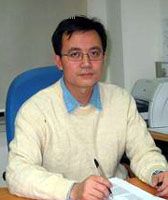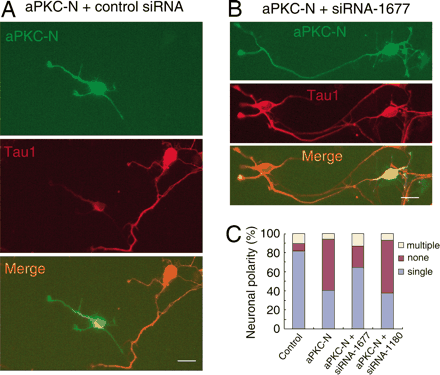PNAS:罗振革教授发现神经轴突发育新机制
时间:2006-06-02 16:29 来源:bioon 作者:admin 点击:次
联系方式: Zhenge Luo, Ph.D. 神经传导信息必须是有次序的,而实现这种有次序的信息传导是依靠神经细胞的特殊结构,即神经细胞的极性。所谓极性是指一个神经细胞通常有两种纤维,即树突和轴突,其中树突专门用来接收信号,轴突则只用来发送信号。科学家发现,每个神经元有多个树突,但轴突却只有一个。 5月30日的《美国科学院院报》(PNAS)发表了中科院神经科学研究所关于神经细胞极性建立的最新研究成果。该工作表明一种调节微管(microtubule)组装和稳定性的激酶MARK2在神经轴突发育过程中起重要作用,抑制MARK2的活性导致轴突的过度生长,而过高的MARK2活性则抑制轴突的生长。在发育过程中,与PAR-3和PAR-6形成复合物的非典型蛋白激酶C(atypical protein kinase C, aPKC),通过负性调节MARK2的活性而降低微管相关蛋白tau的磷酸化,从而引起微管在轴突的组装和轴突的延伸。该工作不仅揭示了神经细胞极性建立的新机制,而且对神经损伤修复和神经退行性疾病的治疗提示了新思路和靶点。该项工作是在罗振革研究员指导下,由陈延民博士为第一作者的研究小组历时一年半多时间完成。
原文出处: Y. M. Chen, Q. J. Wang, H. S. Hu, P. C. Yu, J. Zhu, G. Drewes, H. Piwnica-Worms, and Z. G. Luo PNAS 2006 103: 8534-8539; published online before print May 22 2006, 10.1073/pnas.0509955103 [Abstract] [Full Text] [Figures Only] [PDF] [Supporting Information] 罗振革研究员最新文章列表 Luo, Z., Je, H., Wang, Q., Yang, F., Clem Dobbins, G., Yang, Z., Xiong, W., Lu, B., and Mei, L. (2003) Implication of Geranylgeranyltransfersae in Synapse Formation. Neuron, 40(4): 703-717. Luo, Z., Wang, Q., Xiong, W., and Mei, L. (2003) Signaling complexes for postsynaptic differentiation. J Neurocyt., 32(5-8): 697-708 (Review) Z.G. Luo, Q. Wang, J.Z. Zhou, J. Wang, M. Liu, X. He, A. Wynshaw-Boris, W.C.Xiong, B. Lu, L. Mei. Regulation of AchR clustering by Dishevelled Interacting with MuSK and PAK1. Neuron 2002; 35(3):489-505. (Featured in Neurobiology Paper Alert, Curr. Opinion Neurobiol. 12:463-470, 2002) Hamblet, N., Lijam, N., Ruiz-Lozano, P., Wang, J., Yang, Y., Luo, Z., Mei, L., Chien, K., Sussman, D., and Wynshaw-Boris, A. (2002) Dishevelled-2 is essential for cardiac outflow tract development, somite segmentation, and neural tube closure. Development, 129(24): 5827-5838. Huang, Y., Wang, Q., Won, S., Luo, Z., Xiong, W., and Mei,. (2002) Compartmentalized NRG signaling and PDZ domain-containing proteins in synapse structure and function. Int J Dev Neurosci., 20(3-5): 173-185. 中国科学院神经科学研究所 神经科学研究所的主要研究领域:分子和细胞神经生物学,发育神经生物学、神经遗传学、系统和行为神经生物学、认知神经科学及神经退行性疾病。 从2000年起神经科学研究所承担了国家“973”研究项目《脑发育和可塑性的基础研究》,已取得了较好的进展,已有60余篇论文发表在国际一流学术刊物Science、Nature、Cell、 Nature Neuroscience、 Nature Cell Biology、 Neuron、 PNAS. USA、 J. Neurosci、 Bichemistry、 Cerebral Cortex、 Eur. J. Neurosci.、 J. Physiol.、J. Comp. Neurol.等。 脑发育和可塑性基础研究团队被授予“中国科学院2001—2002年度重大创新贡献团队”称号。中国科学院为调整和加强神经科学研究力量,1999年11月在上海正式建立中国科学院神经科学研究所。中国科学院聘请美国加州大学伯克利分校神经生物学教授蒲慕明担任神经科学研究所的所长。蒲慕明教授是国际著名的神经科学家,在国际神经科学界享有很高的威望。他是神经轴突生长和突触可塑性研究的国际权威,其研究工作在Nature 、Science杂志上发表论文近三十篇。研究所的任务是开展神经科学前沿领域研究,力争取得国际一流的研究成果和培养优秀人才。为此,研究所从国内外招聘优秀的年轻科学家,并为他们提供高强度的研究支撑。研究所建立新的体制和运行机制,提供:(1)严谨的和有利于相互切磋的学术环境;(2)有利于科研人员获得重要科研成果的管理和支撑系统;(3)以业绩为标准的晋升和资助体系;(4)培育高质量年轻一代神经科学研究人员的制度与环境。 神经科学研究所已组建了14个研究组, 预计到2006年将有15-17个研究组,以后年均新建2个研究组,到2010年将达到30个左右研究组。 获聘的研究组长将得到接近国际水平的研究启动费及年研究运行费。研究所为研究人员提供研究分子、细胞和系统神经生物学的先进仪器装备。 神经科学研究所的主要研究领域:分子和细胞神经生物学,发育神经生物学、神经遗传学、系统和行为神经生物学、认知神经科学及神经退行性疾病。 从2000年起神经科学研究所承担了国家“973”研究项目《脑发育和可塑性的基础研究》,已取得了较好的进展,已有60余篇论文发表在国际一流学术刊物Science、Nature、Cell、 Nature Neuroscience、 Nature Cell Biology、 Neuron、 PNAS. USA、 J. Neurosci、 Bichemistry、 Cerebral Cortex、 Eur. J. Neurosci.、 J. Physiol.、J. Comp. Neurol.等。 脑发育和可塑性基础研究团队被授予“中国科学院2001—2002年度重大创新贡献团队”称号。 |
- 上一篇:解读今天的遗传疾病治疗
- 下一篇:科学家研究称遗传因素决定你能否成为企业家

